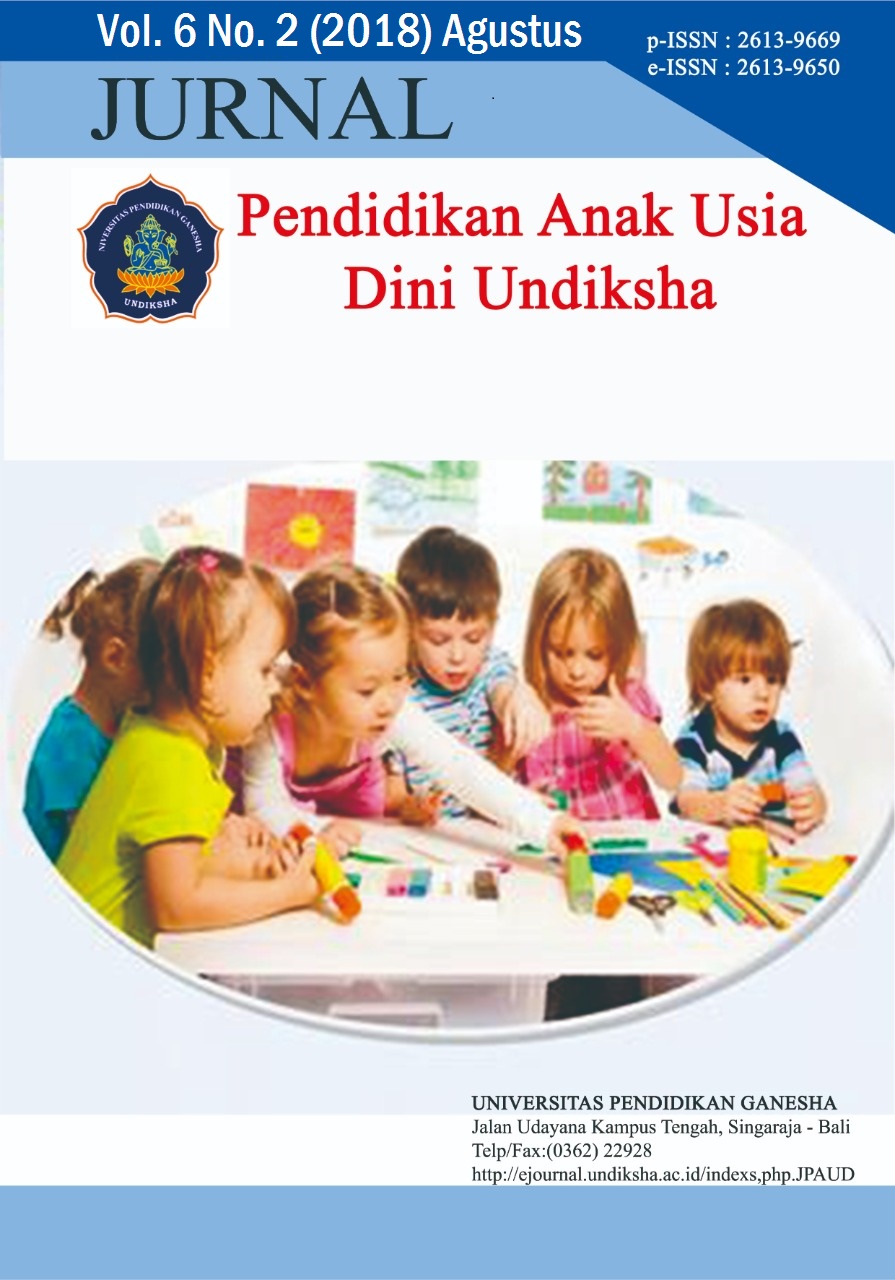Pengaruh Metode Show And Tell Terhadap Kemampuan Berbicara Anak Kelompok B Taman Kanak-Kanak
DOI:
https://doi.org/10.23887/paud.v6i2.15324Abstract
Penelitian ini bertujuan untuk mengetahui perbedaan hasil kemampuan berbicara anatara kelompok yang dibelajarkan dengan metode Show And Tell dengan kelompok anak yang dibelajarkan dengan metode ceramah. Pebelitian ini termasuk penelitian semu yang menggunakan desain non- equivalent posttest only control group design. Sebanyak 20 orang anak kelompok B1 Taman Kanak-Kanak Negeri Kampung Baru dilibatkan sebagai kelompok eksperimen dan 25 orang anak kelompok B1 Taman Kanak-kanak Kasih Ibu dilibatkan sebagai kelompok kontrol. Teknik pegumpulan data menggunakan teknik observasi, kemudia data yang terkumpul dianalisis dengan menggunakan uji-t. Hasil penelitian ini menemukan bahwa terdapat perbedaan hasil kemampuan berbicara antara kelompok anak anak yang dibelajarkan dengan metode show and tell dengan kelompok anak yang dibelajarkan dengan metode cermah (konvensional) kelompok B. Hal ini ditunjukkan dengan hasil signifikan yaitu 5% dengan derajat kebebasan 43 maka, thitung >ttabel yaitu 10,379 > 2,000. Jadi H1 diterima dan HO ditolak. Skor rata-rata siswa kelompok eksperimen yaitu 24,00, dan skor rata-rata kelompok kontrol yaitu 19,08. Hal ini berarti skor rata-rata kelompok eksperimen>skor rata-rata kelompok kontrol, sehingga dapat disimpulkan penerapan metode Show And Tell berpengaruh terhdap kemampuan berbicara pada anak kelompok B di TK Gugus II Kecamatan Buleleng Tahun Pelajaran 2017/2018. Berdasarkan penelitian ini dapat disarankan metode show and tell dapat digunakan memecahkan masalah dalam pengembangan kemampuan berbicara anak.Kata Kunci : Kemampuan Berbicara, Show And Tell
This study aims to determine differences in the ability of the ability to speak between group that is taught by the method of Show and Tell with a group of children who were taught by lecture method. This research includes false research using non-equivalent design posttest only control group design.Sebanyak 20 orang anak kelompok B1 in Taman Kanak-Kanak Negeri Kampung Baruinvolved as an experimental group and 25 children of the group B1 in Taman Kanak-kanak Kasih Ibuinvolved as a control group. Data collection techniques using observation techniques, then collected data were analyzed by using uji-t. The results of this study found that there are differences in the ability of speaking between groups of children who were taught by the show and tell method with groups of children who were taught by the method of mirror (conventional) group B. This is indicated by significant result that is 5% with degree of freedom 43 then, t hitung > t tabel 10,379> 2,000. So H1 is accepted and HO is rejected. The average score of the experimental group students was 24.00, and the control group's average score was 19.08.This means the average score of the experimental group> the average score of the control group, so it can be concluded the implementation of the Show and Tell method influences the ability to speak in the group B in TK Gugus II Kecamatan Buleleng year of learning 2017/2018.Based on this research, it can be suggested that show and tell method can be used to solve problems in developing children's speaking ability.
keyword : Speaking Ability, Show And Tell
Published
2018-07-27
How to Cite
., N. K. T. P., ., D. D. P. P. M., & ., D. P. A. A. S. M. (2018). Pengaruh Metode Show And Tell Terhadap Kemampuan Berbicara Anak Kelompok B Taman Kanak-Kanak. Jurnal Pendidikan Anak Usia Dini Undiksha, 6(2), 148–157. https://doi.org/10.23887/paud.v6i2.15324
Issue
Section
Articles
License
Authors who publish with the Jurnal Pendidikan Anak Usia Dini Undiksha agree to the following terms:
- Authors retain copyright and grant the journal the right of first publication with the work simultaneously licensed under a Creative Commons Attribution License (CC BY-SA 4.0) that allows others to share the work with an acknowledgment of the work's authorship and initial publication in this journal.
- Authors are able to enter into separate, additional contractual arrangements for the non-exclusive distribution of the journal's published version of the work (e.g., post it to an institutional repository or publish it in a book), with an acknowledgment of its initial publication in this journal.
- Authors are permitted and encouraged to post their work online (e.g., in institutional repositories or on their website) prior to and during the submission process, as it can lead to productive exchanges, as well as earlier and greater citation of published work. (See The Effect of Open Access)











